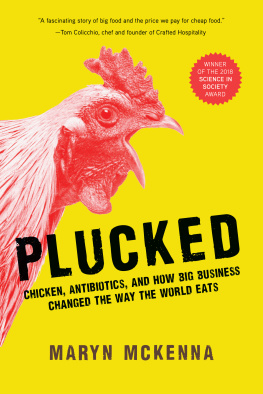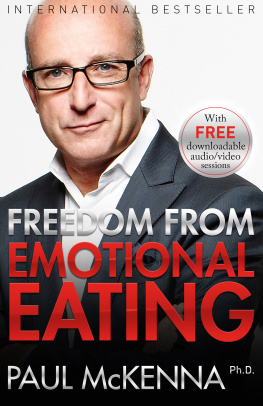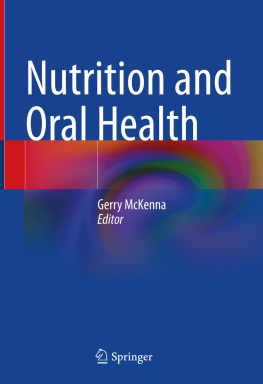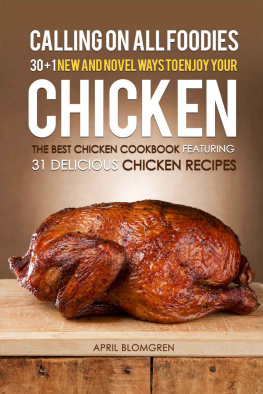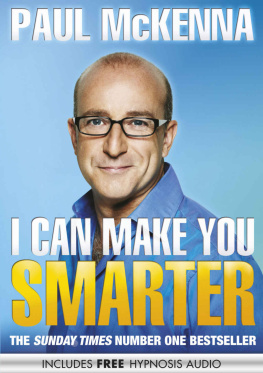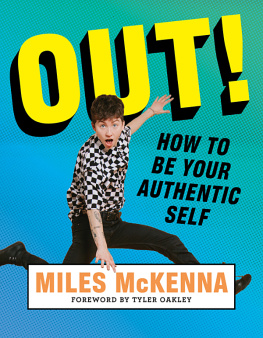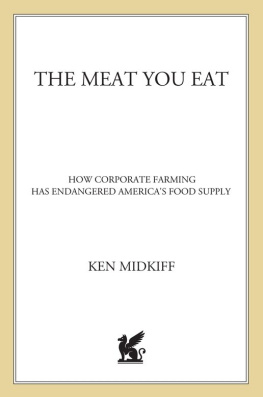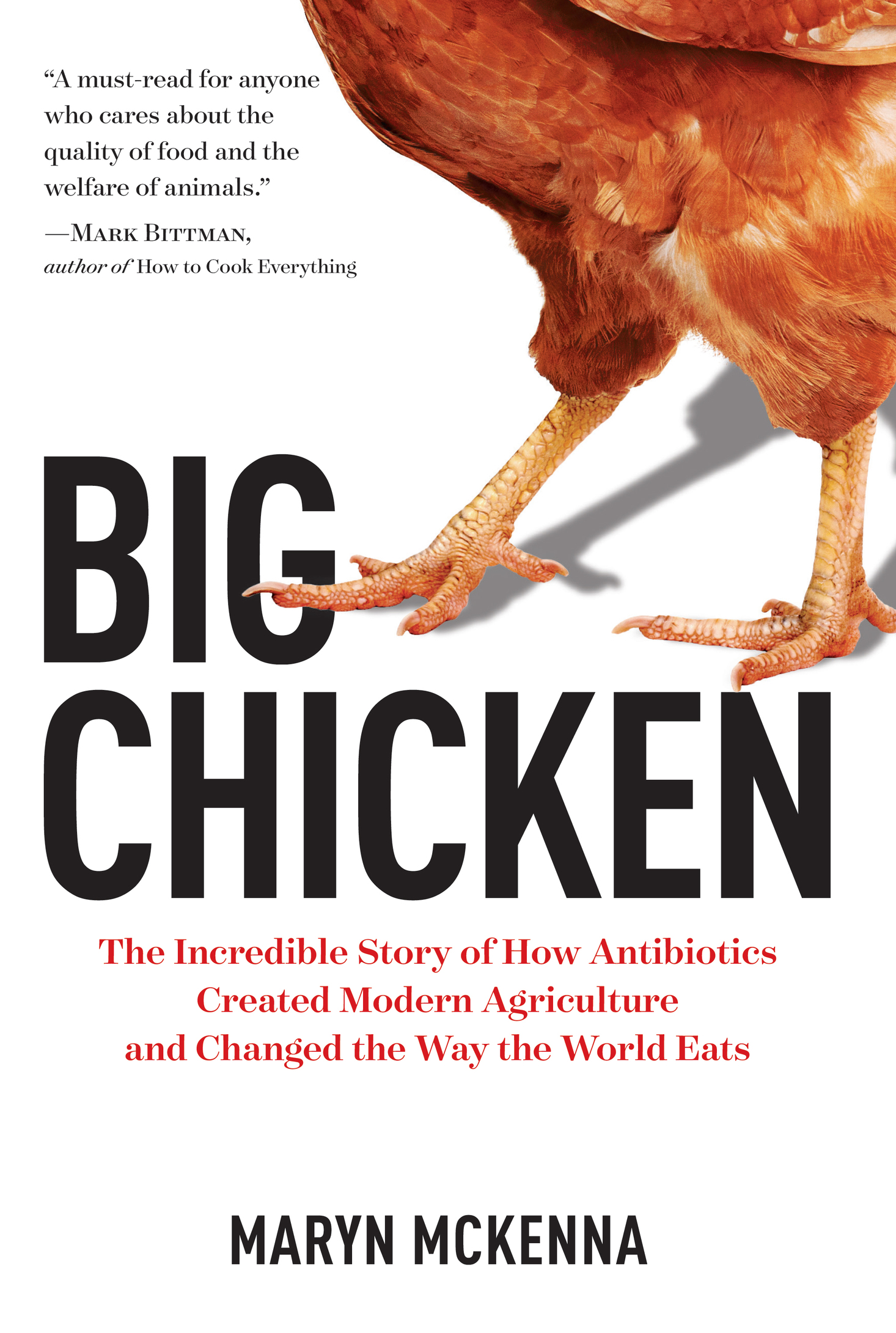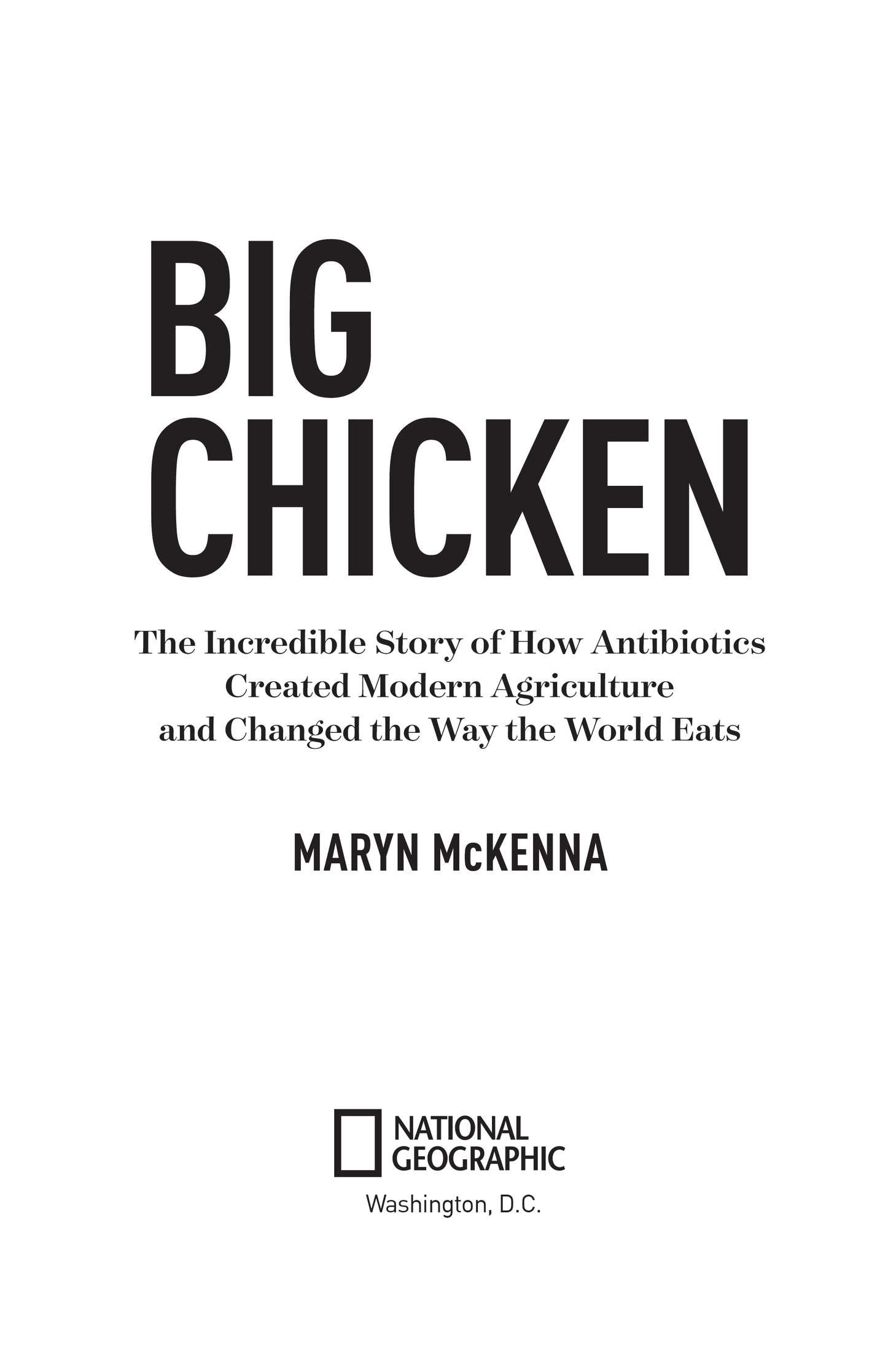Contents
Published by National Geographic Partners, LLC
1145 17th Street NW Washington, DC 20036
Copyright 2017 Maryn McKenna. All rights reserved. Reproduction of the whole or any part of the contents without written permission from the publisher is prohibited.
NATIONAL GEOGRAPHIC and Yellow Border Design are trademarks of the National Geographic Society, used under license.
Library of Congress Cataloging-in-Publication Data
Names: McKenna, Maryn.
Title: Big chicken : the incredible story of how antibiotics created modern agriculture and changed the way the world eats / Maryn McKenna.
Description: Washington, D.C. : National Geographic, [2017] | Includes bibliographical references and index.
Identifiers: LCCN 2017011586 | ISBN 9781426217661 (hardcover : alk. paper)
Subjects: LCSH: Antibiotics in animal nutrition. | Drug resistance in microorganisms. | ChickensMicrobiology. | PoultryMarketing. | ChickensMarketing.
Classification: LCC SF98.A5 M35 2017 | DDC 636.5/0895329dc23
LC record available at https://lccn.loc.gov/2017011586
Ebook ISBN9781426217678
Since 1888, the National Geographic Society has funded more than 12,000 research, exploration, and preservation projects around the world. National Geographic Partners distributes a portion of the funds it receives from your purchase to National Geographic Society to support programs including the conservation of animals and their habitats.
National Geographic Partners
1145 17th Street NW
Washington, DC 20036-4688 USA
Become a member of National Geographic and activate your benefits today at natgeo.com/jointoday.
For rights or permissions inquiries, please contact National Geographic Books Subsidiary Rights:
Interior design: Katie Olsen
v4.1
a
ADVANCE PRAISE FORBIG CHICKEN
Big Chicken is a fascinating story of big food and the price we pay for cheap food.
T OM C OLICCHIO , chef and founder of Crafted Hospitality and co-founder of Food Policy Action
If you think raising farm animals on antibiotics is nothing to worry about, Big Chicken will change your mind in a hurry. Maryn McKennas account of the profit-driven politics that allowed widespread antibiotic resistance should be required reading for anyone who cares about food and health.
M ARION N ESTLE , author of Food Politics
A modern Upton Sinclair, Maryn McKenna explains how our food is actually produced today. Big Chicken is highly readable, shocking, and opens our eyes to the risks we have been incurring. A most important book!
M ARTIN B LASER , M.D., author of Missing Microbes
Drug-resistant infections are among the greatest challenges of our time. Maryn McKenna makes this challenge personal and compelling, illustrating how antibiotic resistance has been developing, why we should care, and what we should all demand to address it.
J EREMY F ARRAR , M.D., P H. D., director of the Wellcome Trust
You will never look at chicken nuggets the same way again after you read Maryn McKennas meticulously researched, riveting bookand you shouldnt. Brava, McKenna, for a tour de force of environmental, science, and food writing.
L AURIE G ARRETT , Pulitzer Prizewinning writer and author of Betrayal of Trust
Maryn McKennas enthralling book is ostensibly about chicken but is really about us: the foolish choices we have made and the happier, healthier future that awaits if we liberate this most American of foods from the drug fix we have imposed on it. Her deep, careful reporting respects every nuance but builds to a clarion call that is as persuasive as it is profound.
D AN F AGIN , author of the Pulitzer Prizewinning Toms River
Maryn McKenna has told an important and frightening storyand told it compellingly. As she makes clear, getting antibiotics out of routine food production will make our food tastier and safer and help fight against antibiotic resistance around the world.
T HOMAS R. F RIEDEN , M.D., former director of the Centers for Disease Control and Prevention
Maryn McKenna is the leading journalist worldwide on antibiotic overuse and resistance. In Big Chicken she tells a crucial part of that story: the vast misuse and overuse of antibiotics in industrial farming. This clear, urgent explanation of how we got here and whats at risk should be required reading for anyone who wants to see change happen.
L ANCE B. P RICE , P H .D., founder and director of the Antibiotic Resistance Action Center
Always curious, never pedantic, Maryn McKenna shows empathy for man and sympathy for fowl, while giving voice to scientists and farmers who have concluded that antibiotic-drugged chickens imperil the American diet.
J OHN T. E DGE , author of The Potlikker Papers
This important book is a must-read for anyone wanting to understand why our approach to producing food is unsustainableand the changes we must make if we dont want to return to a pre-antibiotic era.
R ICHARD E. B ESSER , M.D., president and CEO of the Robert Wood Johnson Foundation
For Bob Lauder
On this earth there are plagues and there are victims, and its up to us, as much as possible, not to join forces with the plagues.
Albert Camus, The Plague, 1947
I think any industry producing meat for almost the price of bread has got a big future.
Henry Saglio, to the U.S. House of Representatives, 1957
CONTENTS
PROLOGUE
EVERY YEAR I SPEND SOME TIME in a tiny apartment in Paris, seven stories above the mayors offices of the 11th arrondissement. The Place de la Bastillethe spot where the French Revolution sparked political change that transformed the worldis a 10-minute walk down a narrow street that threads between student nightclubs and Chinese fabric wholesalers. Twice a week, hundreds of Parisians crowd down it, heading to the march de la Bastille, stretched out along the center island of the Boulevard Richard Lenoir.
Blocks before you reach the market, you can hear it: a low hum of argument and chatter, punctuated by dollies thumping over the curbstones and vendors shouting deals. But even before you hear it, you can smell it: the funk of bruised cabbage leaves underfoot, the sharp sweetness of fruit sliced open for samples, the iodine tang of seaweed propping up rafts of scallops in broad rose-colored shells. Threaded through them is one aroma that I wait for. Burnished and herbal, salty and slightly burned, it has so much heft that it feels physical, like an arm slid around your shoulders to urge you to move a little faster. It leads to a tented booth in the middle of the market and a line of customers that wraps around the tent poles and trails down the market alley, tangling with the crowd in front of the flower seller.
In the middle of the booth is a closet-size metal cabinet, propped up on iron wheels and bricks. Inside the cabinet, flattened chickens are speared on rotisserie bars that have been turning since before dawn. Every few minutes, one of the workers detaches a bar, slides off its dripping bronze contents, slips the chickens into flat foil-lined bags, and hands them to the customers who have persisted to the head of the line. I can barely wait to get my chicken home.


